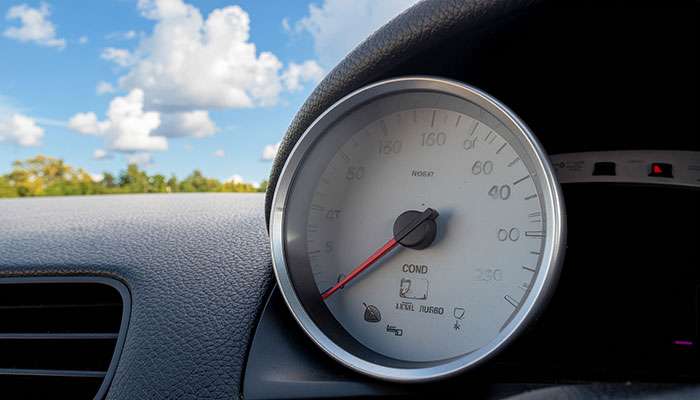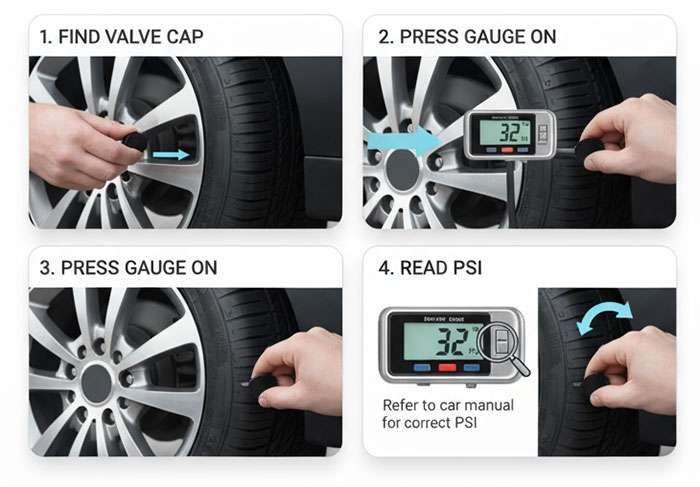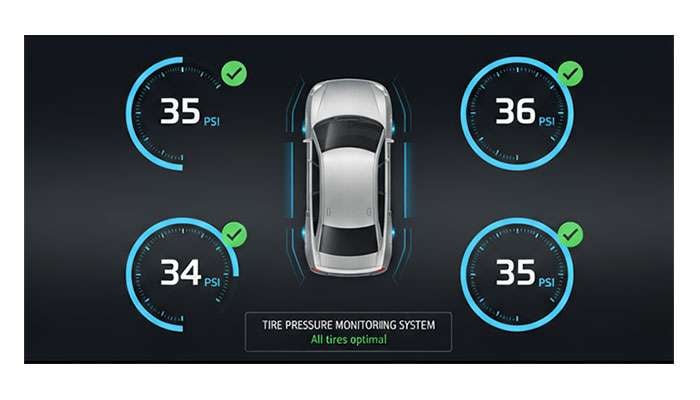
When your tires reach 200 degrees Fahrenheit, real damage begins to occur and a blowout is often not far behind. This critical threshold marks the point where rubber compounds start to deteriorate, significantly compromising tire integrity.
We understand that tire safety is essential for every driver on the road. Most tires sold in the US are designed with specific temperature ratings - 62% rated as Class A (able to dissipate heat effectively at speeds over 115 mph), 34% as Class B (effective between 100-115 mph), and 4% as Class C (effective between 85-100 mph). The ideal maximum tire temperature for safety is around 185°F.
Exceeding this threshold can result in blowouts, reduced traction, and premature wear. Hot tires can get under normal conditions, what factors cause dangerous overheating, and most importantly, how you can prevent potentially catastrophic tire failures. This guide covers everything you need to know about tire temperature limits and how to keep your tires performing safely.
The tire industry uses a standardized system to measure heat resistance capabilities. Understanding these temperature ratings helps you make better decisions about tire selection and safety limits for your specific driving needs.
The Uniform Tire Quality Grade (UTQG) rating system, established by the US Department of Transportation, includes temperature grades as one of three essential measurements alongside treadwear and traction. These grades show how well your tires can resist heat buildup and dissipate it effectively during different driving conditions.
Every passenger tire sold in the United States must earn at least a C rating to meet the National Highway Traffic Safety Administration (NHTSA) safety standards. A-rated tires provide superior heat resistance, but all properly rated tires (A, B, or C) are considered safe for normal driving conditions on North American roads. Think of these ratings as performance levels rather than a pass-fail system - they indicate how much heat stress your tires can handle.
Each temperature grade corresponds to specific speed capabilities where tires can effectively manage heat:
A Rating: Effectively dissipates heat at speeds greater than 115 mph (62% of US tires)
B Rating: Effectively dissipates heat at speeds between 100-115 mph (34% of US tires)
C Rating: Effectively dissipates heat at speeds between 85-100 mph (4% of US tires)
These ratings also correlate with maximum temperature thresholds:
A-rated tires: Can withstand temperatures up to 249°F at speeds of 115+ mph
B-rated tires: Can withstand temperatures up to 230°F at speeds between 110-115 mph
C-rated tires: Can withstand temperatures up to 212°F at speeds between 85-100 mph
Your tires naturally heat up during driving due to friction with the road surface and the constant flexing of rubber compounds. After about 30 minutes of highway driving, tire temperatures typically rise about 50°F above the ambient temperature. If it's 75°F outside, your tires will likely reach around 125°F.
Street tires perform best between 140-170°F under normal conditions. Performance racing tires may function optimally at temperatures approaching 200°F. Once temperatures exceed 195°F, rubber compounds begin breaking down, creating potentially dangerous situations.
Many modern vehicles equipped with Tire Pressure Monitoring Systems (TPMS) alert drivers when tire temperatures surpass 158°F - well before reaching critical thresholds. This early warning system gives you time to address issues before they become dangerous.

Temperature plays a crucial role in tire safety. Most experts consider the line between safe and dangerous to be clearly defined.
Once tire temperatures reach 195°F to 200°F, you're entering the danger zone. This threshold represents the point where rubber compounds begin experiencing structural changes that compromise safety. According to Bendix, a commercial vehicle safety company, 195°F marks the "line in the sand" beyond which temperature starts negatively impacting tire life. This critical limit applies to all tires, regardless of whether they're on passenger vehicles or commercial trucks.
At 200°F, tire rubber begins to break down and flex excessively. This breakdown compromises the integrity of essential tire components including the treads, bead, casing, and sidewall. The tire experiences increased contact with the road surface, creating a dangerous cycle of heat buildup. This affects fuel efficiency and rolling resistance while making the tire increasingly vulnerable to failure.
Tires don't typically pop immediately from ambient heat alone but can certainly blow out when multiple factors combine. As temperatures rise and internal air pressure increases, the weakened rubber becomes increasingly susceptible to sudden failure. Studies show that over 30% of commercial truck tire failures stem from heat buildup and improper inflation. While gradual degradation occurs first, sudden catastrophic failure becomes increasingly likely as temperatures remain elevated.
While 195-200°F represents the initial danger threshold, structural integrity significantly deteriorates around 250°F. At this temperature, tires begin losing their fundamental strength, experience tread reversion, and become prime candidates for blowouts. For comparison, race tires are specifically designed to function at temperatures between 180-215°F, with some performance tires operating effectively at temperatures as high as 248°F.
Looking for tires designed to handle varying temperature conditions safely? Check out Performance Plus Tire's selection of quality tires engineered for optimal heat resistance and safety.

Several factors can push tires beyond their safe temperature thresholds. Understanding these causes helps prevent potentially dangerous situations on the road.
Underinflated tires create excessive friction with the road surface, rapidly generating heat. This extra surface contact builds up thermal energy that can eventually lead to blowouts if left unchecked. Low tire pressure increases stopping distances by 10% to 20%, making emergency maneuvers more dangerous. Even a small pressure reduction affects efficiency—each 1 PSI drop below recommended levels reduces gas mileage by 0.2%.
Speed dramatically affects tire temperature. Driving faster than a tire's maximum speed rating builds dangerous heat levels that may trigger premature failure. Overloaded vehicles place excessive pressure on tires, causing them to flex more and generate additional heat. Extended high-speed driving on hot roads can push internal tire temperatures above 180°F. Aggressive driving for 90+ minutes substantially increases blowout risk.
External conditions play a crucial role in tire performance. For every 10°F increase in ambient temperature, tire pressure rises approximately 1-2 PSI. Tests show a tire kept in shade reached 36.5 PSI from a starting 35 PSI, while an identical tire in direct sunlight soared to 40 PSI. Pavement itself can reach 140-150°F on 100°F days, transferring this heat directly to tire surfaces.
Mismatched tires generate excess heat and increase failure risk. Approximately 44% of tires in unbalanced dual setups experience temperatures exceeding the critical 200°F threshold. Even a seemingly minor 5 PSI difference between paired tires can push them into the danger zone. Different tread patterns result in uneven wear and inconsistent traction, particularly dangerous during braking or cornering.

Keeping tire temperatures within safe ranges requires proper monitoring and regular maintenance. Several key strategies work together to prevent potential blowouts and extend tire life.
Modern TPMS technology serves as your first line of defense against overheating. These systems use sensors that monitor both pressure and temperature, providing real-time data via dashboard displays or smartphone apps. Many systems update readings several times per minute while driving and check every 15 minutes while parked. This constant monitoring allows early detection before temperatures reach dangerous levels.
Smart TPMS configurations include customizable temperature thresholds. Setting alerts around 158°F—well before the critical 195°F danger zone—gives you plenty of time to address issues. Advanced systems like Tire Linc provide visual and audio notifications with color-coded alerts: green for normal conditions, yellow for concerning temperatures, and red for dangerous levels.
Regular visual inspections are essential between drives. Look for cracks, blisters, bulges, or excessive wear—all signs of potential internal heat damage. These inspections become even more important during summer months when road temperatures can exceed 140°F.
Maintaining manufacturer-recommended pressure levels is your most effective prevention strategy. Check pressures early morning when tires are "cold" and consult load inflation tables for optimal PSI settings based on vehicle weight.
Looking for tires with superior heat resistance? Check Performance Plus Tire's selection of quality options designed to maintain safety across various temperature conditions.
Understanding dangerous tire temperatures is essential for safe driving and optimal vehicle performance. The 195-200°F threshold marks where tire compounds begin breaking down, significantly increasing blowout risks. We've covered how the UTQG rating system classifies tires based on heat resistance capabilities, with most U.S. tires falling into the A or B categories for superior performance.
Your tires typically operate safely between 140-170°F under normal conditions. Several factors can push temperatures into dangerous territory - underinflation creates excessive friction and heat buildup while reducing fuel efficiency and handling. High speeds, overloading, extreme ambient temperatures, and mismatched tires all contribute to potentially dangerous overheating.
You can take several proactive steps to prevent tire temperature issues. Use a Tire Pressure Monitoring System with alerts set around 158°F to provide early warnings before reaching critical thresholds. Conduct regular visual inspections for bulges, cracks, or unusual wear patterns that indicate heat damage. Maintain proper inflation based on manufacturer specifications, adjusting for load and weather conditions.
The difference between safe driving and a dangerous blowout comes down to these simple preventative measures. Modern tires feature impressive engineering and safety margins, but they require proper care to perform reliably. Maintaining awareness of tire temperatures, especially during summer months or long highway drives, keeps you safe on the road.
We believe in providing the knowledge and products you need to drive with confidence. Understanding tire temperature limits helps you make better decisions about maintenance, driving habits, and tire selection for your specific needs.
Understanding tire temperature limits can prevent dangerous blowouts and save lives on the road.
• Critical danger zone begins at 195-200°F - tire rubber compounds start breaking down at this temperature, significantly increasing blowout risk
• Underinflation is the leading cause of overheating - low tire pressure creates excessive friction and heat buildup that can push temperatures into dangerous territory
• Set TPMS alerts at 158°F for early warning - this provides ample time to address issues before reaching the critical 195°F threshold
• Check tire pressure when cold and maintain manufacturer specifications - proper inflation based on load charts is your most effective prevention strategy
• Most US tires are A-rated (62%) for superior heat resistance - these can effectively dissipate heat at speeds over 115 mph and withstand up to 249°F
Remember that tire safety isn't just about avoiding blowouts—proper temperature management also improves fuel efficiency, extends tire life, and ensures optimal vehicle handling in all driving conditions.
Tires become dangerous when they reach temperatures between 195°F to 200°F. At this point, the rubber compounds begin to break down, compromising the tire's structural integrity and significantly increasing the risk of a blowout.
Under normal driving conditions, tires usually operate best between 140°F and 170°F. After about 30 minutes of highway driving, tire temperatures can rise approximately 50°F above the ambient temperature.
Several factors can cause tire overheating, including underinflation, high speeds, excessive vehicle load, high ambient temperatures, hot road surfaces, and mismatched tire types or tread patterns.
To prevent tire overheating, maintain proper tire inflation based on manufacturer recommendations, use a Tire Pressure Monitoring System (TPMS) with alerts set around 158°F, conduct regular visual inspections for signs of wear or damage, and avoid overloading your vehicle.
Tire temperature ratings (A, B, or C) indicate a tire's ability to dissipate heat at different speeds. A-rated tires (62% of US tires) can effectively handle heat at speeds over 115 mph, while B-rated (34%) and C-rated (4%) tires have lower heat resistance. These ratings help ensure tire safety under various driving conditions.